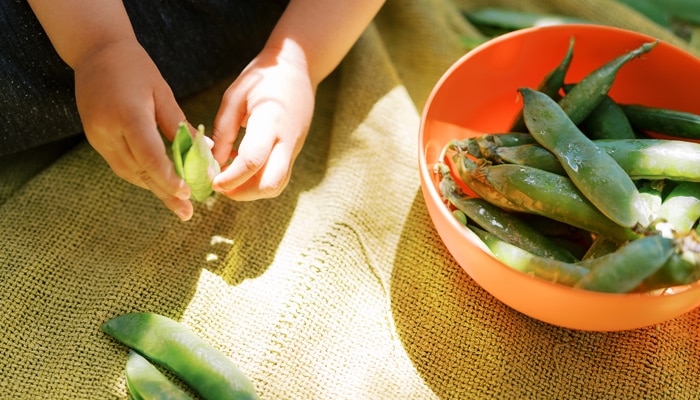While we believe that the books and resources recommended may be of value to you, keep in mind that these are suggestions only and you must do your own due diligence to determine whether the materials are appropriate and suitable for your use. PNC has no sponsorship or endorsement agreement with the authors or publishers of the materials listed.
FARM TO PRESCHOOL

Plant Parts We Eat
Child will graph parts of plants that we eat.

Lesson Objective
Children will learn about the different parts of plants that everyday foods come from and which parts we eat.
Science
What You'll Need
- Pictures of everyday foods that come from plants such as carrots, radishes, lettuce, spinach, squash, cucumbers, tomatoes, corn, beans, peas, broccoli, cauliflower, asparagus, and celery – 1 picture per child
- Diagram of a plant with the parts identified – roots, stem, leaves, flowers, seeds, fruit (from an Internet search)
- 5' long piece of butcher paper taped to a wall
- Marker
- Tape
What To Do
Note: Before beginning the activity, divide the butcher paper into 6 sections.
- Display the food pictures, and have the children identify them.
- Tell the children that all of these foods come from plants and that many of them are grown on farms.
- Explain that every plant has basically the same parts (see Did You Know?).
- Display the plant diagram, and review the parts of the plant (roots, stem, leaves, flowers, seeds, and fruit).
- As the children repeat the parts of the plant to you, write each plant part on one section of the butcher paper.
- Distribute the everyday food pictures – 1 per child.
- Tell the children that each of the crops is part of a plant and they will need to decide which plant part their food picture matches.
- Give the children some time to compare the food pictures with the plant diagram.
- As children identify the plant part that their food matches, help them to tape it to the appropriate column on the butcher paper.
- Explain that all of these foods that we eat come from different plant parts, but not all parts of every plant can be eaten.
Resources
Home School Resources
Home educators: use these printable lesson PDFs to teach this lesson to your home schoolers. They're available in English and Spanish.
Content Provided By
Common Core State Standards Initiative – These lessons are aligned with the Common Core State Standards ("CCSS"). The CCSS provide a consistent, clear understanding of the concepts and skills children are expected to learn and guide teachers to provide their students with opportunities to gain these important skills and foundational knowledge [1]. Visit the CCSS


